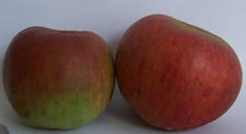Hampshire Apples such as the Bramley are well known but what of Hambledon’s Deux-ans?
The cooking apple known as the Hambledon Deux Ans, originated in the village of Hambledon in about 1750 or at least that is when it is first recorded growing in a garden there. There is something very special about growing a plant whose history is tied to a specific location. Fruit trees played an important role in the lives of our forebears. When preserved, they provided a source of vitamins for the depth of winter when little else was available. Hence the punishment often handed out to children when they were caught ‘scrumping’ fruit from trees, it was a valuable food source.
There are a number of Hampshire Apples, perhaps the best known is the cooking apple, the Bramley, named after the village of Bramley in Hampshire but there are other Hampshire Apples worth seeking out. Varieties of apple can be searched by name or location.
The Hambledon Deux-ans is a striped tart cooking apple, that can still be found growing in some gardens in the village. The tree is locally called the ‘Hambledon Dozen’ and the apples are said to capable of being kept stored for up to two years. This is a valuable assett in an apple as many trees have an abundant year, producing more fruit than can be eaten, followed by a lean year. Although the origins of these Hampshire apples are lost in time, some think the tree was imported from France. Its growth pattern more reflects the shape of french apple tree than an English and of course the name alludes to it being french.
As we know, many travellers to the continent in the C18th brought home plants to grow in their own gardens. It is possible that a Hambledonian returned home with seeds from an apple that he had enjoyed on a sojourn in France and the Deux-ans took its place amongst the Hampshire Apples.

